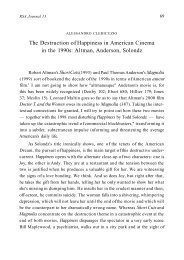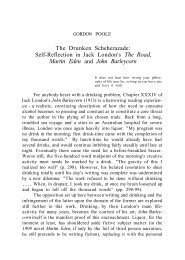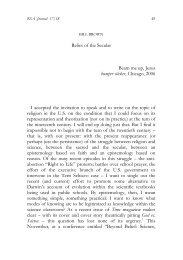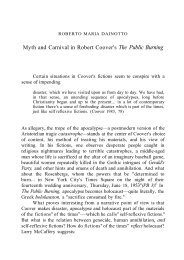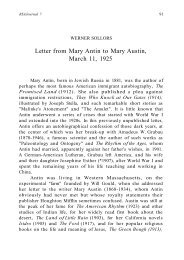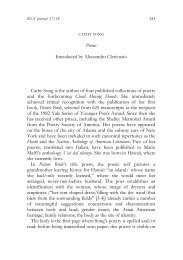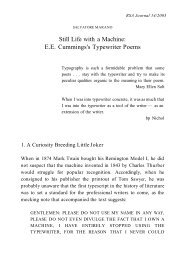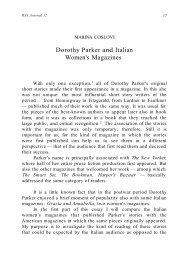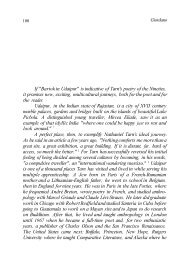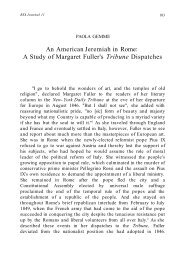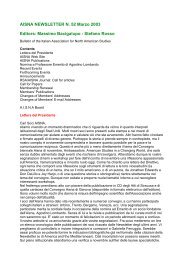NEWSLETTER #56 - aisna
NEWSLETTER #56 - aisna
NEWSLETTER #56 - aisna
You also want an ePaper? Increase the reach of your titles
YUMPU automatically turns print PDFs into web optimized ePapers that Google loves.
AISNA Newsletter 56, p. 32<br />
odyssey is reduced to ludicrous proportions, gangrened by absence : "And those women were<br />
roughly able to sing songs of the skewered lamb and waters driven back by faith or oath. They were<br />
dry. The boards on which they sat, scraped of fodder, might have burst aflame if the sun were<br />
caught briefly in the eye of a watch glass. They traveled in three lifeless dories with dead oarlocks<br />
and rotted sails; they sang stiffly; managed to hold the reins. They backtracked, chewed the sand<br />
and made their way over weary, salty miles to see one woman their own age brought to bed" (82).<br />
Such nefarious visions would only spell an inversion of values were it not for a syntax that<br />
stubbornly performs deprivation and loss, a rhetoric of the once-was gnawed at by a host of<br />
privatives and cancellations that leave no chance to idealized values or the could-bes of<br />
representation : "Not a gull circled their heads, there were no rushes from which the crane could<br />
jump and fly with its ill-concealed legs and gawky call. The last drippings of the river lay eighteen<br />
feet deep […] backed without roe or salamander into the shallows"(133) : descriptions feed on what<br />
the reader may have salvaged of less bankrupt visions to animate a landscape of nightmare.<br />
The fantasmatic apparition of Mississippi steamboats in the imagination of women playing<br />
poker (76) follows a negative description of times not only gone by but laminated into nonexistence:<br />
[Thegna] "had tacked no rawhide sheets across the window, no smoke heavy on<br />
eyeshades filled the room. There were no watch chains on embroidered waistcoats, no weapons<br />
concealed in the finery, the feathered fronts of silken shirts. Black cigars, gold teeth, long wallets<br />
next to hot and scented breasts, these were buried under the young willow limbs of wing dams on<br />
the river." At the end, as Luke is killed by his own gun, when comes "that cool baying of the rising<br />
head, the call to kill, louder and singsong, […] the nasal elated sounds of the cowboy's western<br />
bark," its sound reads weak and whimpering: "Yip, yip, yip."<br />
For the name of his protagonist in Yellow Back Radio Broke-Down, "The Loop Garoo Kid",<br />
Ishmael Reed used that of actor Lash LaRue who, in the forties, embodied "the man in black" and<br />
"the king of the bullwhip" in "Song of Old Wyoming". And for one of his three epigraphs, an<br />
excerpt from "The Rustler", a cowboy song that refers to "the hoodoos". The villain, here, is "Bo<br />
Shmo and the neo-social realist gang" (38). When he "lean[s] in his saddle and scowl[s] at Loop,<br />
whom he consider[s] a deliberate attempt to be obscure. A buffoon an outsider and frequenter of<br />
sideshows" (38), he prefigures the reception the book met from conservative critics. Loop Garoo's<br />
retort speaks for Reed's eclectic position in his all-out attack on genre itself : "What's your beef with<br />
me, Bo Shmo, what if I write circuses ? No one says a novel has to be one thing. It can be anything<br />
it wants to be, a vaudeville show, the six o'clock news, the mumblings of wild men saddled by<br />
demons." (40) "Collage", "jigsaw", "circus", "an expedition into the unknown" (29), the novel<br />
methodically implements a no-holds-barred strategy of crazed havoc. Born in a psychedelic age that<br />
lends its colors to the revolt of the children who "decide[…] to create [their] own fiction"(18),<br />
against the grownups and the old of Yellow-Back Radio, it savages received ideas, official<br />
historiography and usual distributions. It reverses ideological and racial logics, as when the first<br />
page upgrades "spades" to "trump", when the barkeep wryly declares that "one of them historians<br />
remarked […] the real American personality begins with the frontier" (63), when an epigraph<br />
reminds us that "Roy Rogers' movie double's name was Whitey Christensen". The black and white<br />
dots separating sections do more than remind us of the logo of a famous radio brand : they install<br />
the reversal of black and white, of cat and dude, of voodoo and western at the typographic heart of<br />
the text.<br />
The novel ransacks popular genres and artistic currents. The caricature of Pope Innocent as<br />
mafioso is inserted in a cartoon-like episode where he sprays a preacher with DDT, relayed by the<br />
sci-fi comic strip tonality of the landing of the Flying Brush Beeve Monster (42) out of which<br />
strides "a plainclothes, patarealist Indian" (43), cigarette holder in hand : Chief Showcase, partial to<br />
Pierre Cardin originals, expatiates on a dubious traditional friendship between Blacks and Indians<br />
(48). Giant Sloths, straight out of horror comics, frolic among monstrous characters borrowed from<br />
gore, vaudeville and slapstick fond of "Jive talking dada" (155) ; a queer green mustang keeps<br />
having surrealist nightmares and dreams of World War II; a corrupt congressman from New Jersey



